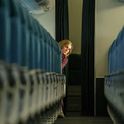New things. Here is one. A monthly celebration of the finest graphic novels in publication, which we’re calling—with all the imagination of a stone—“Graphic novel of the month”. Compared to Prospect’s reviews of normal, pictureless books, you could even say that this is a new thing about new things, seeing how relatively recent the medium of graphic novels is. It’s novelty squared.
Except you’d be wrong. As any reader of Scott McCloud’s superlative Understanding Comics will assure you, graphic novels are part of a tradition of sequential narrative imagery that goes back through Max Ernst, through William Hogarth, through 15th-century experiments in printing, through the Bayeux Tapestry, all the way to ancient Egyptian paintings, if you like. Of course, we don’t just want to celebrate graphic novels because of this lineage—we like them anyway—but lineage is certainly part of the appeal. Turns out, this is a new online column about very old things.
So what is our first graphic novel of the month? Aptly enough, it is a story about the past—a primordial horror, in fact—called A Guest in the House, both written and illustrated by Emily Carroll. In its short prelude, a sort of dream sequence for modern-day protagonist Abby, a knight slices through the belly of a dragon. “I, beneath, would find stillness in the hot viscera,” the knight says. Much of Carroll’s work so far, including what follows in A Guest in the House, suggests that she, too, might find stillness in viscera.
Some of the imagery here is indeed visceral. Carroll knows just when to punctuate her mostly black-and-white art with a dash of—often crimson—colour. Rotting things appear from around corners; chunks of meat gain weird life. Sometimes the panels themselves spill open like bellies, turning the form itself from something rectangular and straightforward to something messy and challenging.
But none of this is overdone. In fact, after A Guest in the House’s prelude, you might almost be lulled into a sense of… if not security, then at least familiarity. That dreamer, Abby, has moved into a lakeside house with her husband, David, and his daughter, Crystal, from a previous marriage. She works in the local store in the day, prods at her folds in the mirror at night, and generally worries about how she can live up to the role of being Crystal’s new mum—especially since Crystal, in that tropiest of tropes, has started drawing disturbing pictures in crayon at school.
And then? Abby starts to wonder and learn more about the previous wife, Sheila, who, early on at least, becomes a great, unavoidable, unseen presence. So, you wonder yourself, isn’t this just du Maurier’s Rebecca with a modern, demotic twang?
Ever so skilfully, though, Carroll introduces variations on her theme. Sheila doesn’t actually remain unseen—she emerges from the lake, a sodden, undead being who has the power to affect the look and garb of a ghostly damsel (reflecting that knight from the dream). So Abby finds herself investigating a mystery: what put Sheila in the water and why is her spirit so restless? And also her own sexuality: “I think about the form she took,” Abby says to herself of damsel-Sheila, “and my face goes so hot.”
But this is not what you’d call a love story. It’s more a slow peeling back of secrets and the people who keep them… one after another, until… the final, wrenching secret of all.
Which is? Ha! I shan’t tell. The darkening evenings of autumn approach, which is the perfect time to read A Guest in the House and discover that some things are very old indeed. Older even, you suspect, than graphic storytelling—and certainly more wicked.














